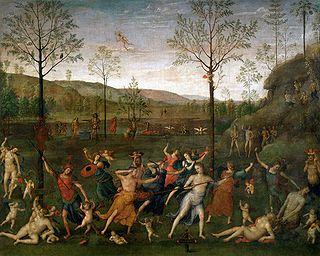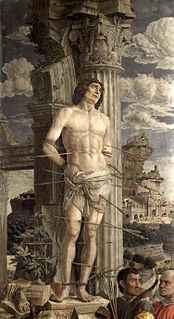This page is based on this
Wikipedia article Text is available under the
CC BY-SA 4.0 license; additional terms may apply.
Images, videos and audio are available under their respective licenses.

St. Sebastian is the subject of three paintings by the Italian Early Renaissance master Andrea Mantegna. The Paduan artist lived in a period of frequent plagues; Sebastian was considered protector against the plague as having been shot through by arrows, and it was thought that plague spread abroad through the air.

The Lamentation of Christ is a painting of about 1480 by the Italian Renaissance artist Andrea Mantegna. While the dating of the piece is debated, it was completed between 1475 and 1501, probably in the early 1480s. It portrays the body of Christ supine on a marble slab. He is watched over by the Virgin Mary and Saint John and St. Mary Magdalene weeping for his death.
The decade of the 1460s in art involved some significant events.

The Triumph of the Virtues is a painting by the Italian Renaissance painter Andrea Mantegna, executed in 1502. It is housed in the Musée du Louvre of Paris.

The Camera degli Sposi, sometimes known as the Camera picta, is a room frescoed with illusionistic paintings by Andrea Mantegna in the Ducal Palace, Mantua, Italy. During the 15th century when the Camera degli Sposi was painted, Mantua was ruled by the Gonzaga who maintained Mantua’s political autonomy from its much stronger neighbors Milan and Venice by bidding their support out as a mercenary state. Ludovico III Gonzaga, the commissioner of the Camera degli Sposi and the ruler of Mantua at the time, himself trained as a professional soldier, was looking to give the Gonzaga rule more cultural credibility with his commissioning of Andrea Mantegna in a humanist Renaissance political landscape in which other courts such as the Ferrara were commissioning their own “painted chambers”. The room chosen to be painted is on the first floor of a northeast tower in the private section of the Ducal Palace, with windows on the north and east walls overlooking Lago di Mezzo. This room would have been used for several different private and semi-private functions such as a bed chamber for Ludovico, a gathering area for family and close courtiers, and a reception room for particularly important guests. The semi-private functions of the room helped to create an air of exclusiveness to the Camera degli Sposi meant to impress viewer with the wealth and cultural prestige of the Gonzaga without an overt or gaudy display. The room itself was renovated before Mantegna began painting to be as close to a square as possible with the dimensions of roughly eight by eight meters wide and seven meters tall. Original architectural features of the room include the triple vaults on each wall, a fire place on the north wall, doorways on the west and south walls, and windows on the north and east wall. Painted between 1465 and 1474, The Camera degli Sposi became well known shortly after its completion as a masterpiece in the use of both trompe l'oeil and di sotto in sù.

The Presentation at the Temple is a painting of the Presentation of Jesus at the Temple by the Italian master Giovanni Bellini, dating to c. 1460. It is housed in the Fondazione Querini Stampalia, in Venice, Italy.

The Adoration of the Shepherds is a painting by the northern Italian Renaissance artist Andrea Mantegna, dated to c. 1450-1451.

The Battle Between Love and Chastity is a painting by the Italian Renaissance artist Pietro Perugino, currently housed in the Musée du Louvre, in Paris, France. It was originally commissioned for the studiolo (cabinet) of Isabella d'Este, Marchesa of Mantua, in the Castello di San Giorgio.

The Parnassus is a painting by the Italian Renaissance painter Andrea Mantegna, executed in 1497. It is housed in the Musée du Louvre of Paris.

Portrait of Francesco Gonzaga is a painting by the Italian Renaissance artist Andrea Mantegna. It is housed in the National Museum of Capodimonte, Naples, Italy.

The Presentation at the Temple is a painting by the Italian Renaissance artist Andrea Mantegna. Dating to c. 1455, it is housed in the Gemäldegalerie, Berlin, Germany.

The Crucifixion is a panel in the central part of the predella of a large altarpiece painted by Andrea Mantegna between 1457 and 1459 for the high altar of San Zeno, Verona (Italy). It was commissioned by Gregorio Correr, the abbot of that monastery.

"The Revolutionist" is an Ernest Hemingway short story published in his first American volume of stories In Our Time. Originally written as a vignette for his earlier Paris edition of the collection, titled in our time, he rewrote and expanded the piece for the 1925 American edition published by Boni & Liveright. It is only one of two vignettes rewritten as short stories for the American edition.

The Mantegna funerary chapel is one of the chapels of the Basilica of Sant'Andrea, Mantua. It houses the tomb of the painter Mantegna and his last two paintings - Baptism of Christ and Holy Family with St John the Baptist, St Elizabeth and St Zacharias (1504-1506). Its frescoes from 1507 were painted by his sons Ludovico and Francesco and by a young Correggio. The tomb bears a bronze figure of Mantegna by Gianmarco Cavalli.

The Madonna of the Caves is a tempera on panel painting measuring 32 cm 29.6 cm. It was painted in 1488-1490 by the Italian painter Andrea Mantegna and is now in the Uffizi Gallery in Florence.

Descent into Limbo is a 1492 tempera and gold on panel painting by Andrea Mantegna, now in the Barbara Piasecka Johnson Collection in Princeton, New Jersey. It depicts the Descent into Limbo of Jesus Christ. There are also drawings of the subject by Mantegna in the École Supérieure des Beaux-Arts in Paris, whilst Giovanni Bellini also painted the subject.
'Judgement of Solomon is a tempera on canvas painting attributed to Andrea Mantegna and his collaborators. Dating to around c.1495 and is now in the Louvre, it imitates a marble bas-relief and the only surviving preparatory drawing may be in Mantegna's own hand.

















